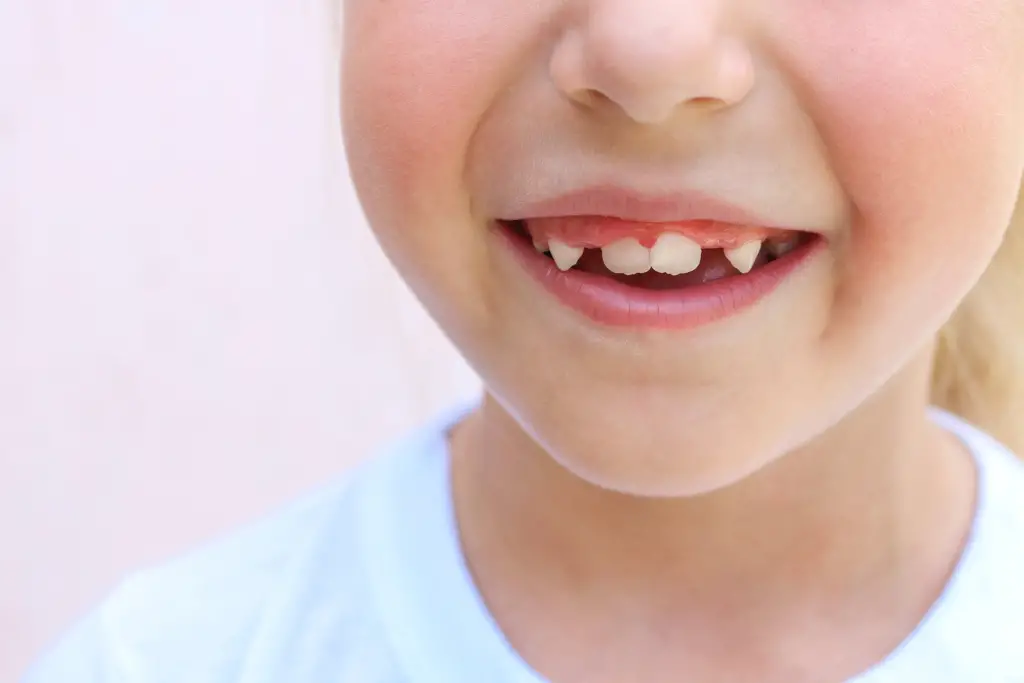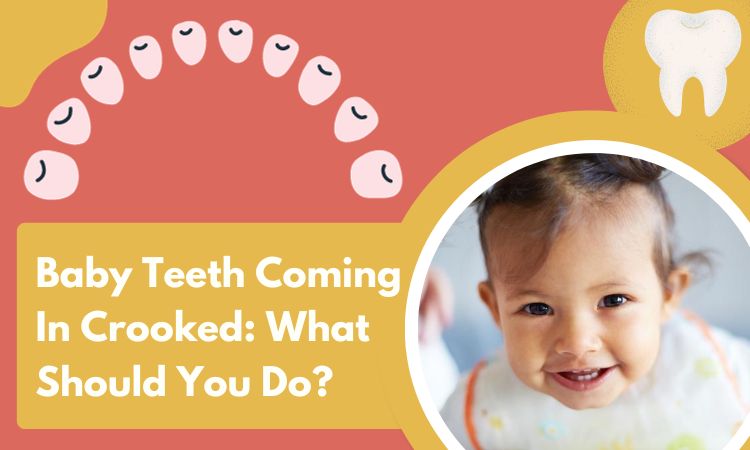Baby teeth can come in crooked because of hereditary issues, bad habits, untimely loss of teeth, and excessive teeth. In general, your baby’s crooked teeth will be replaced naturally when they become adults. However, to straighten the teeth you can use options such as braces, clear aligners, and retainers.
There are more things to consider while dealing with crooked teeth. To know all about them and other details about why your baby teeth coming in crooked, check out the entire article.
Key Takeaways
- Baby teeth can come in crooked when there are hereditary issues. Also, it can happen because of a lack of good habits, excessive teeth, and untimely loss of teeth.
- Common types of crooked baby teeth are crowded teeth, angled teeth, and crooked bottom teeth.
- To straighten the crooked teeth, you can use braces, clear aligners, retainers, and palatal expanders.
- To keep the teeth healthy, follow a proper toothbrushing routine and a healthy diet. Also, drinking plenty of water is necessary. In addition, visiting the dentist for routine checkups is essential.
Why Do Baby Teeth Become Crooked?
There are various reasons for the child’s baby teeth coming in crooked. Some of them are beyond our control, whereas others can be dealt with. In this section, we will discuss the most common reasons your baby’s teeth can become crooked.
Heredity:
This factor causing a baby’s teeth to come in crooked is not in our power to influence. To illustrate the genetic factor, let us give you an example.
If your partner has large teeth and your jaw is slight, there is a possibility that the primary teeth of your child will have narrower than usual spaces between them because they will take their jaw from you, and the size of the teeth — from your partner. The wide spaces will result in crooked baby teeth.
Bad Habits:
Certain recurrent actions your child takes can lead to the child’s primary teeth being crooked. Such habits are known as myofunctional. One of the ‘bad’ habits is when your child sucks their thumb.
Seemingly harmless, the habit of thumb sucking increases the stress on the bottom teeth and the upper teeth. For a child’s tooth development, it can have a significant impact resulting in crowded teeth or an open bite. So thumb sucking is worth discouraging.
Another habit is a pacifier. We have nothing against this useful tool, but there is a time for everything. And there is time to stop giving a pacifier to your child. Prolonged pacifier use can cause primary teeth issues like pushing forward the upper front teeth. When that happens, the child’s bite deviates from normal (open bite).
You need to stay vigilant and watch closely the developing teeth of your child. At this point, negative impacts can be often reversed.
Untimely Loss Of Baby’s Teeth:
This can happen for various reasons. A child can lose a tooth in an accident. Another possibility is tooth decay or gum disease. Free space is gradually occupied by the other teeth causing the crooked child’s teeth effect.
Unfortunately, it can also cause consequences for permanent teeth, as there will be an obstruction for the child’s adult teeth when they are ready to come in. And crooked permanent teeth, although also curable, still present a larger problem than crooked primary teeth.
Excessive teeth:
This is not a common phenomenon, but it occurs from time to time and causes crowded and crooked teeth.
Types of Crooked Baby Teeth You Might See
Teeth can become crooked in different ways, and below you’ll find the most common types of ‘crookedness’ that baby teeth can have.
Crowded teeth:
A proper gap between the teeth doesn’t exist, and sometimes there is even an impression that the teeth are ‘trying’ to invade each other’s space. When permanent teeth are coming in, they can face a problem in such a situation. So it’s time to consult a pediatric dentist who will find the best solution.
Angled teeth:
It happens both with primary and adult teeth. Normally, the teeth will gradually straighten properly without any external assistance, but following the process with a pediatric dentist is a reasonable solution, too.
Crooked Bottom Teeth:
Sometimes baby teeth come in resembling a V shape. It mostly happens with bottom teeth and is usually a temporary occurrence.

Should You Be Worried When Your Baby’s Teeth Becomes Crooked?
Your perfect baby has crooked baby teeth coming in. Can it be a sign of a major problem? Of course, you are getting anxious and feel the pressure to take action. It’s natural. Although, in this particular case, you most likely don’t need to worry.
To start, those are baby teeth. Your child is not going to live with them for all their life. They will get their adult teeth in several years.
But even then, it won’t be the final verdict, because modern pediatric dentistry can offer effective solutions for the child’s teeth issues.
Did you know that our teeth start growing even before our birth? By the time we leave our mother’s womb and say hello to the new world, we have 10 upper and lower teeth (20 in total and no wisdom teeth for the infants) hidden in the gums. When the first tooth comes in, a child is around 6 months old (the age varies, of course).
They eventually end up with 20 baby teeth, which are very often not ideal. Crooked teeth are a common occurrence.
Although it’s usually not the reason for great concern, visiting a pediatric dentist is a sensible idea. According to the American Academy of Pediatric Dentistry’s recommendation, you should bring your baby for a primary visit to the pediatric dentist after the child’s teeth start to come in or around their first anniversary.
You understand that the first years are a period of fast development, the baby’s teeth included. The face grows and with it, the mouth and the jaw. Misaligned teeth can easily align by the age of 6. Don’t view the position of primary teeth as the permanent one.
But a regular visit to the dentist is still sensible because a specialist will watch a development process with vigilance and alert you about any potential deviations.
How Do You Treat Your Baby’s Crooked Teeth?
When you go to the dentist for a regular checkup, they’ll check if your teeth are straight or not. If your teeth are fine and not causing any problems, you can choose to keep them as they are.
But if you want to straighten them, your dentist might send you to a special dentist called an orthodontist.
An orthodontist is a dentist who helps fix crooked teeth and jaws. They’ll look at your mouth, teeth, and jaw to decide if you need treatment.
There are a few ways to straighten teeth:
- Braces: These are metal wires and brackets that dentists adjust regularly.
- Clear aligners (like Invisalign): These are clear trays that can make your smile better quickly, and they’re hard to see.
- Retainers: These can fix slightly crooked teeth when they’re crowded.
- Palatal expanders: For kids, if their mouth is too small for their future teeth, a special device can help widen it.
Tips to Keep Your Baby’s Teeth Healthy
Prevention is key. A healthy care routine for your child will secure proper tooth development.
It’s up to the parents to encourage their child to adhere to good oral hygiene.
Here are several basic rules that will give you excellent results in the form of your child’s brilliant smile.
- Start teaching your baby the toothbrushing routine with the appearance of the first tooth. Use a very soft brush and very little paste at the beginning adding to it gradually. When the child has more teeth and they are close to one another, it’s time to floss, too.
- Healthy eating habits are a must. You need to train their palate. Healthy food is delicious, and they can see it if given a chance. Sweets and sugary drinks are not friends of healthy teeth.
- Make water your children’s drink of choice. Teach them to drink it throughout the day to sate their thirst. Sweets and sugary beverages are better limited as much as possible.
- Going to see the dentist should become a routine. Preventing an issue or catching it at an early stage is always preferable.
What to Do If Your Child’s Permanent Teeth Growing Crooked?
Crooked adult teeth can arise due to various factors. Genetics may play a role, with a family history of bite or tooth alignment problems potentially being passed down to your child.
External factors can also impact the development of permanent teeth. For example, forceful thumb-sucking or facial injuries can affect how teeth align.
Additionally, some children naturally have teeth that grow in unconventional ways. Initially, their permanent teeth may appear crooked but gradually improve with time.
If you notice your child’s teeth seeming misaligned initially, there’s no need to panic. Often, these issues resolve themselves as teeth continue to grow and settle into their proper positions.
Nonetheless, it’s crucial to consult a dentist if these alignment problems cause your child pain or affect their speech and eating habits. Even if the problems seem minor, a dentist can assess the situation and rule out any underlying concerns.
Furthermore, early intervention is vital if your child requires correction for their tooth alignment. A pediatric dentist can monitor their smile and ensure they receive the appropriate care at the right time.
Frequently Asked Questions (FAQs):
Why Are My Child’s Teeth Coming In Sideways?
Teeth can come in sideways for a few reasons. For instance, it can happen when a child’s mouth is too small and there isn’t enough room for their adult teeth to come in properly. Another reason is when a baby’s tooth doesn’t fall out when it should. As a result, the adult tooth might grow sideways in the gum.
Can Teething Cause Crooked Teeth?
No, teething cannot cause crooked teeth. Other reasons make teeth crooked, like family genetics or the baby’s habits, like thumb sucking. Extra teeth, though rarely occurring, can also cause crooked teeth.
How Common Is Crooked Teeth?
The majority of people, around 90%, have teeth that are somewhat out of alignment. Also, about 75% of us have wisdom teeth that don’t have sufficient space to come in correctly. In other words, our teeth often don’t fit well in our mouths.
Conclusion
If your child’s baby teeth are coming in crooked, it’s not a reason to panic. However, staying vigilant is reasonable, as tooth development is an important process that parents should follow closely.
Watch out for any potential problems and start regular visits to the pediatric dentist as soon as the first teeth come in. Although baby teeth are a temporary thing, they can influence permanent teeth and thus should be taken seriously.
More Related Guides
Why Can't You Store Breast Milk in Bottles With Nipples? [3 Reasons]
Best Soap to Use After Giving Birth: Read Before You Buy!
How long can baby sleep in mini crib: a detailed guide
8 Best Healthy Smoothie Recipes For Kids (Nutritious + Delicious)

Mo is a home-based Mommie and a passionate journalist. She loves to help other moms to spend a good life.

